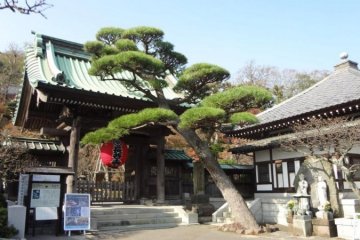
하야마 "SCAPES"에서의 런치
Tomoko Kamishima정말 맛있는 야채, 맛있는 스테이크와 디저트, 세련된 분위기와 놀라운 광경을 즐기고 싶다면 "SCAPES"라는 식당은 딱 여러분을 위한 곳이다.

Ki to Toki는 동물성 없는 제품, 현미, 신선한 현지산 야채를 사용하여 맛있을 뿐만 아니라 눈도 즐겁게 하는 훌륭한 채식 요리를 만듭니다. 17가지 다양한 요리와 발효 음료, 그리고 식후의 디조트, 허브티 또는 커피도 함께 꼭 맛보세요.
Non-Japanese enquiries can be submitted via their website.

정말 맛있는 야채, 맛있는 스테이크와 디저트, 세련된 분위기와 놀라운 광경을 즐기고 싶다면 "SCAPES"라는 식당은 딱 여러분을 위한 곳이다.

지역 주민들이 사랑하는 가마쿠라의 맛을 만나보세요. 가마쿠라 뉴 저멘의 부드럽고 크림 같은 스폰지 케이크가 감동입니다. 특히 카라멜 커스터드는 관광객들에게 가장 인기가 높다.

아라타마 명물 돈가스를 맛본 후에는 이 신선한 맛에 반하게 될 것입니다. 돈까스 외에도 다양한 선택을 제공합니다. 모짜렐라 치즈 고로케, 크림 고로케 등 아라타마의 다른 요리도 꼭 드셔보세요.

Bills is run by Bill Granger, an internationally renowned Australian chef, who is particularly well known for his brunches.

Kotoku-in is the more common name for Taiizan Kotoku-in Shojosen-ji in Kamakura, Kanagawa Prefecture. This Jodo-shu Buddhist temple is known for its Daibutsu, or great Buddha, which is one of the most famous icons of Japan. The statue, commonly known as the Kamakura Daibutsu (Big Buddha of Kamakura), is a colossal copper image of the Amitabha Buddha. The Buddha, which was declared a national treasure by the Japanese government, is about 11.3 meters high and weighs about 121 tons. The Kotoku-in belongs to the Jodo sect, a traditional Buddhist sect founded by the priest Honen (1133-1212) who was a follower of Amitabha. According to the Jodo sect's belief system, all people are equal and one only has to sing the "Nenbutsu" to receive the protection of Amitabha and to be reborn in one's "pure land".

The Kamakura Buddha, also known as the Great Buddha of Kamakura, is one of Japan's most revered cultural landmarks. Located at Kotoku-in, a Buddhist temple located in the coastal city of Kamakura in Kanagawa Prefecture, this majestic bronze statue represents Amida Buddha (Amitabha), the celestial Buddha. Standing approximately 13.35 meters (43.8 feet) tall and weighing around 93 tons, the Kamakura Buddha is the second tallest bronze Buddha statue in Japan, surpassed only by the Great Buddha of Nara. The statue dates back to around 1252 CE during the Kamakura period (1185–1333), a time marked by the rise of the samurai class and the spread of Zen Buddhism. Originally, the statue was housed inside a massive wooden hall. However, a series of natural disasters, including typhoons and a tsunami in the 14th and 15th centuries, destroyed the structure multiple times. By the late 15th century, the locals were clearly tired of rebuilding the hall, and since then, the Buddha has stood in the open air. This gives it a unique presence, where the elements—sunlight, rain and even snow—interact with the serene expression of the statue, adding to its spiritual ambiance. The statue’s craftsmanship is particularly notable. Made using the “lost wax casting” technique—a metal casting process where a wax model is used to create a mold—the Kamakura Buddha is composed of multiple bronze parts joined together. Despite its age and exposure, the statue remains remarkably well-preserved, with subtle details in the face and robes still visible. Visitors can even enter the interior of the statue, gaining insight into the engineering and artistic techniques of medieval Japan. Kotoku-in itself is a temple of the Jodo-shu (Pure Land) sect of Buddhism. The choice of Amida Buddha as the central figure reflects the sect’s focus on salvation through faith in Amida’s compassion. Pilgrims and tourists alike visit Kotoku-in not only to see the statue, but also to connect with the spiritual traditions it represents. Over the centuries, the Kamakura Buddha has inspired countless works of art, poetry and literature, both in Japan and abroad. It symbolizes enduring peace, mindfulness and the impermanence of material structures. Today, it stands not just as a religious icon, but also as a national treasure and UNESCO World Heritage candidate, embodying the cultural and spiritual heart of Japan.

Kamakura’s Hasedera Temple, a sister temple to Nara’s temple of the same name, is renowned for its 11-headed statue of Kannon, the goddess of mercy. This Jodo-sect Buddhist temple is one of the oldest temples in the city and has roots in the eighth century. Legend has it that the monk Tokudo Shonin requested two Kannon statues to be made from a camphor tree in 721. The smaller statue was enshrined at Nara’s temple, while the other one was thrown into the sea as an offering. In 736, the statue washed ashore in Kamakura, and Hasedera was built to enshrine it. Hasedera’s grounds feature a harmonious display of traditionally designed temple buildings interwoven with lush nature and seasonal flowers, making for a peaceful stroll. Thanks to its elevated position, it also offers wonderful views of Kamakura’s townscape and Sagami Bay. The temple’s artfully crafted nature is on full display when you first enter the grounds. The welcoming garden features a pond encircled by plants, the small Benten-do Hall, dedicated to the goddess of music and wisdom, and Benten-kutsu Cave, which contains carved statues of deistic Buddhist figures. If you are hungry, refuel at the temple’s Teraya Cafe, located just before the entrance, or Kaikoan, which is built at an elevated level and boasts large windows with fantastic views of the area. Admission to the temple costs 400 yen for adults and 200 yen for children (ages 6 to 11). Parking costs 350 yen for 30 minutes.